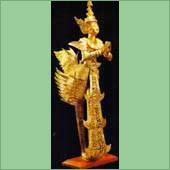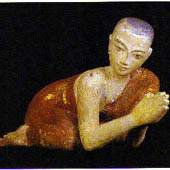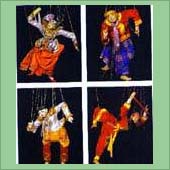
Burmese
John Falconer
Design & Architecture
PeriPlus
Hong Kong 2000
BUY IT
-
Woodcarving
- Jakatas
-
Lokanat
(Boddhisatva Avalokiteshvara)
- Earth Goddess, Monks
-
Kinnara and kinnari
-
Nats
-
Lacquer ware
- Manuscripts, Kammavaca
- Scripture Chests
and Cabinets
-
Embroidered Quilts (Kalagas)
- Bells and Gongs
- Marionette
Woodcarving
The woodcarving of Myanmar is justly famous. Few woodcarvers in the world can
match the technical skills of Burmese artisans in creating designs of great
spontaneity, freedom and intricacy. These designs may first be drawn on paper,
especially ones of great detail. The general outline is cut first with saw,
chisel and axe; then an expert with years of experience (a master woodcarver)
does the carving. Myanmar's great forests must have provided a wealth of material
for woodcarvers in the first millennium and before. While no carvings remain
from that period, those on the wooden lintels above the main entrance to the
hall and the entrance to the shrine of the late 11th century Nagayon,
Bagan, give evidence in their sophistication that they are the product of a
long lineage of woodcarving. Small images of what may be vidhyadhara
(celestial begins who have attained wisdom and magical powers and can fly through
the air) are depicted as fast-moving figures within roundels inside lozenges
and within ellipsoids, the interiors and exteriors of which are ornamented with
delicately carved flowers and what may be clouds. Also of the same period was
a wooden door found at the Shwezigon pagoda, still extant at the turn of the
century, with carved panels of scrollwork, flowers, musicians and dancers all
seated within beaded borders.
These were reserved for monasteries, palaces, royal barges and carriages. Temple
murals in the 12th century Lokahteikpan and the circa 13th
century Chaukpayahlange, plus a red ochre sketch in the Hpayathonzu, also of
13th century Bagan, all depict pyat-that hsaung (buildings
with a tiered roof) with imposing makara pediments on each side and a
many-tiered roof. The Chaukpayahlange shows that the roof tiers and the finial
were heavily carved and were gilded.
By the early part of the 17th century, as witnessed by the designs
of doorways at the Hpowindaung Caves, a great change had taken place in the
relief decorating doorways and windows. The pediments were no longer outlined
by the bodies of two makaras as in classical Bagan, but were decorated
at the sides with saing-baung, ornamented elements in the form of haunches
of a wild ox. Wooden door panels with door guardians in relief attest to the
virtuosity of the local carvers. The murals of these caves depict great palaces
adorned with carved pyat-that and pediments plus royal carriages each
with a carved pyat-that. The 18th century murals of Bangan
indicate the continuation of architectural and woodcarving styles.
In the late 18th and early part of the 19th century, the
capital seesawed between Ava and Amarapura. When King Mindon changed the capital
site from Amarapura to Mandalay in 1857, he dismantled the wooden palace buildings
and restructured them at Mandalay. Thus the remarkable carvings remaining from
the palace now seen at the Shwenandaw monastery in Mandalay may date to a pre-Mandalay
period.
back to the top of the page
Jatakas
Jatakas, stories of the lives of Gotama Buddha prior to his birth as
Prince Siddhattha, appear to have been known in Myanmar at least in the 5th
century. This is evidenced by a large terracotta plaque in high relief from
the Khin-ba mound, Thayekhittaya, identified as depicting an episode in the
Mugapakkha (Temiya) Jataka (No 538). The last ten Jatakas depicting
the last ten lives of the Buddha are a favorite subject of woodcarvers, ceramists
and painters alike. In fact, they have been the most popular stories depicted
in Burmese art since at least the 11th century.
The Mon in southern Myanmar initially followed a recession of 550, Jataka
stories. In the late 11th century, King Kyanzittha of Bagan adopted
the Singhalese recession of 547, which has remained the standard one. Although
Jataka Plaques surely must have been cared of wood during the classical
Bangan period and before, the earliest extant wooden ones date to the Konbaung
Dynasty (1752-1885). The Jataka carvings at the Yoe Soe monastery in
Sa-le reflect a growing interest in portraying the lives of the ordinary people
as found in murals of the Jatakas in 18th and early 19th
century Bagan, and in Western realism introduced later in the 19th
century.
back to the top of the page
Lokanat
(Boddhisatva Avalokiteshvara)
Figures that play an important role in Buddhism such as the Buddha's disciples,
novices and the lokanat (possibly a form of the bodhisattva Avalokiteshvara)
are often found in monasteries and nunneries. Carvings of these figures may
adorn the walls of religious sites and palaces or may be freestanding, and are
accepted as a natural part of the life of the faithful.
back to the top of the page
Earth
Goddess, Monk with a bowl and other characters
Other woodcarvings for devotional use include such examples as the earth goddess
Wathundaye wringing the water from her hair, attesting to the Buddha's right
to Enlightenment because of all the water he ritually poured when he performed
good deeds in his previous lives; Shin Thiwali, a standing monk with bowl and
fan who is the patron saint of travelers; Shin Upangok, a seated monk glancing
upward with his right had in his alms bowl, propitiated for good weather; Thurathati
(Svarasvati) goddess of learning and the guardian of the Buddhist scriptures,
seen riding a hintha with a book in her had; and the tangu-daing,
a tall flagstaff generally decorated with a hintha and a long streamer.
back to the top of the page

Other subjects in which Myanmar woodcarvers' delight are the beings from Buddhist
cosmology and the nats. According to this cosmology, at the four cardinal
points of Mt Meru, the great mountain at the center of the universe, there are
four continents. The southernmost is Jambu, on which is the Himavanta mountain
range and forest. In the latter dwell the kinnara and kinnari,
he half-man and she half-woman respectively, and both half-bird. The kinnara
is depicted in the symmetrical royal attire of the Mandalay period with the
addition of a tall flanged crown. The wings and tail flutter delicately to his
rear. The artist has created a sense of motion and beauty in what could have
been a static figure.
back to the top of the page

Respect for nats is an inherent part of Burmese culture, and carvings
of nats are frequently seen. They may be nature spirits, ones from mythology,
or humans who have died unnatural deaths. Included among the last are those
who constitute a pantheon of 37 nats. Nats are specifically carved to
be placed on pagoda platforms and other Buddhist edifices. As spirits, they
require propitiation, and are also regarded, like humans, as disciples of the
Buddha.
During the 12th century the widespread adoption of Buddhism suppressed,
but never replaced, the pre-Buddhist practice of nat (spirit) worship.
Nat worship dates back to proto- and possibly prehistoric times; originally,
it revolved around land, sky and water spirits, and was obviously linked to
agricultural endeavours. But by the Bang era, historical personages started
gaining spirit status, probably in response to increased cent5ralization of
governing power (giving people martyrs to pay tribute to), and possibly influenced
by similar cuts in India.
Many nats are thought to be descended from people who had died violent,
unjust deaths. These supra-human nats, when correctly propitiated, can
aid worshippers in accomplishing important tasks, the most potent of the nats
make up a well known pantheon of 37, all of whom make Mt Popa their main spiritual
abode. Today this rock outcropping jutting from the plain near Bagan remains
a major point of pilgrimage for many Burmese.
A visit to a temple reveals any number of nats housed in shrines dotted
around the temple compound in apparent contrast with the Buddhist nature of
the place. And on sale in the pagoda alley markets are all the figures in the
37- nat pantheon-and more. These are purchased by the devout, and when
placed in nat kaun (spirit home) shrines in the home, become the recipients
of food, liquor, flowers and other consumables. Thus are the powerful spirits
placated.
back to the top of the page

Among the great artistic achievements of the people of Myanmar is yun,
the generic name for lacquer in Myanmar. Durable and beautiful items are produced
by a time-tested method, the vital element of which is the sap from the Melanorrhoea
usitata tree. First the object to be lacquered is constructed from either
bamboo or wood. The lightest, most pliable lacquer wares are made of interwoven
bamboo strips and horsehair. Other fine wares are made of woven and int4erlaced
bamboo strips. Softwoods are used for screens, folding tables and rectangular
boxes, and teak form heavier pieces. For bamboo, a dried bamboo trunk is cut
into strips, which may be coiled, woven or twisted, as the shape of the object
requires. When the basic form is completed, a coat of lacquer mixed with fine
clay seals it. It is then put into a special cellar to dry for three to ten
days. Afterwards, it is smoothed and polished with pumice on a simple hand lathe,
where upon another and finer sealing layer is added and the object is put back
into the cellar. This process is repeated again and again until the item is
completely smooth. Finally, it is given a coat of fine, glossy-quality lacquer.
Several steps of sealing, polishing, drying and lacquering take place before
an object is ready for final decoration. The lacquer, which comes from the sap
of the wild Melanorrhoea tree, is naturally black. Different colors are
produced with the addition of different elements: red by the addition of cinnabar,
yellow by orpiment, blue by indigo, and green from a mixture of yellow and green.
Blue was rarely used traditionally as a separate color.
More precisely, the term yun is the name of a gloriously imaginative
incised lacquer ware. Here, the artist can show his capacity to bring legends
to life and introduce a plethora of lively motifs. The style originated in China,
and how it came to Myamar and to be centered in Bagan is still debated. The
technique demands skill and patience. An object already covered with a glossy
coat of lacquer is incised sequentially with elements of an overall design to
be presented in chosen colors. Supposing, for example, the background is black.
The artist, working freehand, might first incise lines to be filled with red.
The surface of the object is then entirely covered with the colorant, ensuring
that the lines are also filled with red. It is then placed in a drying cellar
for three or four days, after which the excess of red is removed by polishing
on a lathe. The color is sealed in by a coating of resin. When this is dry,
the engraving of the second color begins and the process continues through the
next color(s).

Since the Shan State is home to the trees from which the best lacquer is derived,
some scholars consider that lacquer ware production came to Bagan via Laikha.
This is still the predominant center of lacquer ware production in the southern
part of the state. Lesser centers are at Ywama and Tha-lei on Inle Lake. The
most important center in the north is Kengtung.
Rare wares whose main surfaces are covered with green lacquer are a notable
product of the Shan State. The green is produced from a mixture of orpiment
and indigo, both of which are found in the region. The orpiment is ground into
a powder, and to it are added ground indigo, translucent gum, lacquer and resin.
Green lacquer may be decorated with yun, shwe-zawa or theyo
designs.
Red and black lacquer produced in the Shan State has a brilliant sheen. This
may be due to the excellence of the lacquer in the region. These colors are
often used in bold juxtaposition to create unusual designs. Many wares tend
to be robust.
Kengtung is noted for the delicacy of had-moulded gilded thayo work,
particularly on rice baskets called kotaute, which have a black lacquer
body, gilded thayo at the top, and panels below bearing figures of a
couple from an ethnic group. These date to the period between the World Wars,
and are now much coveted by collectors.
Relief-moulded lacquer (thayo) receptacles created mostly in Mandalay
for Buddhist votive use constitute an art form in which Myanmar excels. Lacquer
is mixed with sifted paddy husk or cow dung ashes to which pulverized bone is
added for strength, resultiong in a plastic material easily moulded, modelled
or stamped into relief designs. Thayo will adhere to wood, basketry,
stone and metal. When each formed piece of thayo has hardened, it is
lacquered at the rear and appropriately placed. Thayo designs may be
inset with glass. Early glass was backed with mercury-treated foil, but in the
latter part of the 19th century, mirror glass replaced it.
The most spectacular receptacles are the hsun-ok, tall pedestal-bowls
used to offer food to monks. Their covers are surmounted by a pagoda-like finial
at times inset with a hintha (Brahmani duck) or sphere. Monks' alms bowls
(thabeik), covered and lavishly gilded and glass inlaid, are set on a
kalat, a small tray with a stemmed base. Kun-daung, holders for
betel leaves arranged in a spire as an offering, and betel box in the form of
a hintha, are also popular votive object of thayo decoration.
back to the top of the page
Manuscripts,
Kammavaca
The earliest manuscript found in Myanmar was in the 5th century Khin
Ba mound at Thayekhittaya. It is one inscribed with excerpts from the Vinaya
and Abhidhamma (two of the three parts of the Pali Tipitika) on
20 gold leaves 16.5 cm in length and 4 cm in width. It had two gold covers bound
together by a thick gold wire and its ends were fastened to the covers by sealing
wax and small glass beads. Each leaf and comer had two holes through which the
gold wire passed. This is stylistically related to two important manuscript
types, palm-leaf manuscripts and kammavaca, both of which may have been
produced early in the first millennium. The other important type, the parabaik,
appears to date from the 14th century.
From at least the classical Bagan period (11th-13th centuries),
specially processed leaves from the palmyra and talipot palms (borassus flabellifer
and Corypha umpraculifer) were employed as material on which a scribe
incised with a stylus horizontal lines from Buddhist texts, plus other treatises.
Only rarely were diagrams or drawings inscribed. The leaves were rubbed with
oil, earth and soot to preserve them and darken the script. Usually the title
was inscribed on the cover while the donor or author's name and the date appear
at the end. The leaves, once collated, were placed between two boards to secure
them; bamboo rods or string were passed through two holes bored at the center.
Size and decoration varied.
Kammavaca are volumes consisting of one, five or nine extracts from the
Theravadin Vinaya, each relating to specific ceremonies associated with
monks. Noel F Singer writes that the earliest Kammavaca consisted of
folios made of palm leaves, each of which had four lines of square-linked script;
on a gold or silver background ("Kammavaca Texts: Their Covers and Binding Ribbons",
Arts of Asia, 23, May-June 1993). In the 17th century, folios
began to be made of pieces of cloth coated with lacquer and painted with cinnabar,
and the square letters were written in thick, black lacquer. On rare occasions,
folios were of ivory. Designs in gilt which had been reserved for the ends of
folios, and pages and wooden cover boards now began to appear between the lines
of the text. By the second half of the 19th century, the lines of
script on the folio increased to six or seven and sheets of brass or copper
were introduced as folios.
Parabaik are manuscripts created from long strips of accordion-pleated
paper processed from mulberry tree bark. Those for everyday use were darkened
with a powdered charcoal mixture. Markings made by steatite crayons could be
erased and the paper reused. Parabik, coated with a chalk mixture and
polished, often bear beautifully illustrated Buddhist and other texts and have
covers of glass-inset thayo.
back to the top of the page
Scripture
Chests and Cabinets
A library where Buddhist scriptural texts are kept is essential to every monastery.
The texts are arranged in chests or cabinets called sadaik. The importance
attached to these is expressed by the excellence of their craftsmanship. The
body was constructed of wood, traditionally large single teak boards for strength
and durability; it was often set on a high base to protect the texts from insects
and damp, and was frequently covered with elaborate lacquer and inset glass
decoration.
Most sadaik are in the form of long, rectangular chests, dovetailed at
the joints and with a lift-up lid. The one on right is placed on a footed
two level base. It is decorated with lacquer relief moulding covered with gold
leaf and inset with glass, suggesting gemstones. Two rectangular panels enclose
figures within ellipsoids. Between the latter are stemmed lotus buds and blossoms
formed of inset colored glass. The ellipsoids are echoed on the sides of the
base.
Another type rises vertically in three levels and is influenced by European
Victorian furniture. The two lover sections are for manuscripts; the top has
a recess with a glass door to hold a Buddha image.
back to the top of the page
Embroidered
Quilts (Kalagas)
Since the early 1970s, kalagas, colorful sequined hangings with scenes
from the life of the Buddha, Jatakas, and-to lesser extent secular themes,
have been sought after by collectors worldwide. The term, meaning "Indian curtain"
suggests an as yet undetermined Indian derivation. The art began in the mid
17th century and reached its zenith during the reign of King Mindon
(1853-78) when the velvet which often forms the background was both imported
and woven in the palace. The technique ("gold-thread stitching" in Burmese)
involves applique, quilting and couching. Figures, foliage, architectural elements
and so on were cut from the materials which include felt, flannel, cotton, silk,
wool, lace and braid- and were attached to a background cloth of velvet or cotton,
often with its own cotton backing. Sequins, imitation jewels and couched work
in gold and silver tread created a rich appearance. Facial features were usually
painted on.
Most early kalagas are in long rectangular form with stories illustrated
in narrow strips. Architectural elements and foliage serve as scene dividers,
and space is defined by the relative positioning of figures or by colors, for
example, darker in front and lighter at the rear. Today, in the revived industry
in Mandalay, kalagas of varying sizes and themes are made and their technique
is used in the production of a variety of other goods as well.
back to the top of the page
Bells
and Gongs
It is not only in temple compounds and monasteries that one finds bell and gong
in Myanmar. Many Burmese will also display these items-usually bought from a
specialist vendor in the pagoda valley in their homes. They are considered items
of devotion.
The classic designs for Burmese bells and gongs date back many centuries to
an era when clocks had yet to be introduced. In today's Buddhist monasteries,
time is still measured by the sound of padded hammers striking bronze surfaces:
calling the monks to chanting sessions or meditation; announcing alms rounds
or meal times; starting classes in Dhamma (Buddhist philosophy).
Certain gongs and bells are struck freely by visitors to shrines and pagodas
as a form of prayer, homage or supplication. The round, flat gong of Shan origins
produces sharp tones that are a favorite of nat worshippers; the large,
ornate and more mellow-sounding temple bell is sounded three times by Buddhists
paying tribute to the Buddha, the Dhamma and the Sangha (monastic
community).
back to the top of the page

Marionette theatre or yok-thei pwe enjoyed a pre-eminent place in Myanmar's
performing arts tradition in the 18th and 19th centuries.
The movements created by master puppeteers using the colorfully garbed and carefully
assembled jointed wooden puppets in fact influenced the development of zat pwe,
dance-drama later performed by live actors. Even today Burmese classical dance
shows a pronounced similarity to marionette movements.
As in zat pwe, the primary subject matter for Burmese marionette theatre
comes from the Jatakas, Favorite tales include those stories, which emphasize
royal court intrigue and provide moral instruction via the performance's subtext.
Standing up to a meter high, the marionettes may be manipulated by dozen or
more strings. Some of the older, more elaborate figures, particularly those
representing nat or spirit roles, display as many as 60 strings attached
to every moveable part of the puppet, from elbows to eyebrows. A yok-thei
performance displays not only the talents of the puppeteers, but of the singers,
musicians, woodcarvers, embroiders and set designers as well.
Due to the breakdown of royally sponsored classical arts during the British
colonial era and the advent of motion pictures, yok-thei pwe declined
by the 1930s. The puppets themselves, however, are still extremely popular.
back to the top of the page
khmer statue:thai handicraft:asian handicraft:Handicraft thailand:buddha antique:tantrism:bronze buddha